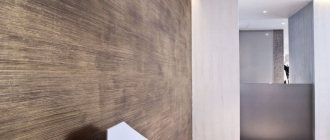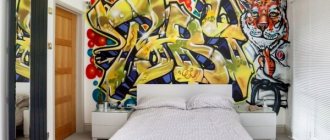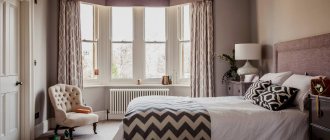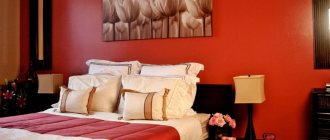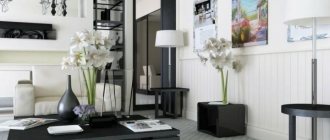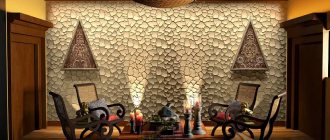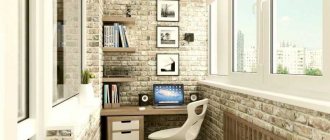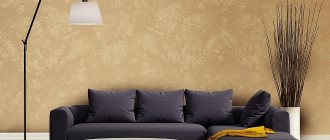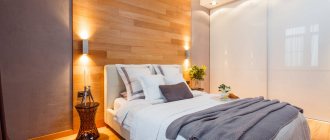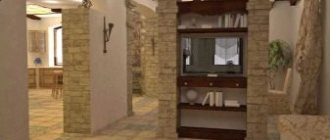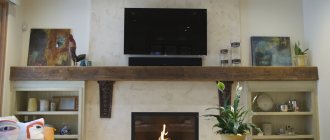Photo: kraski-net.ru Wallpaper has long been turning into a relic of the past, because it is being replaced by much more modern and practical materials. Today we will tell you about decorative plaster, its types, composition and how to apply textured material. Your walls will be smooth, textured and certainly unique!
Advantages of decorative plaster
The greatest value of finishing rooms with decorative plaster is determined by the operational characteristics of the material:
- Particular strength, which is due to the high-quality composition. Even with mechanical damage, chips, cracks, and rough dents do not form on the surface of the plaster.
- The finished composition fits perfectly on any base: brick, masonry, plaster, wood.
- Wall finishing with decorative plaster is usually used to hide unevenness and defects on the underlying walls. Plasticity and a high degree of adhesion make this material indispensable for interior wall decoration.
- This material is absolutely not characterized by the formation of cracks during natural shrinkage.
- Plaster has received special recognition for its versatility. Due to its moisture resistance, the coating is used for finishing bathrooms, hallways, and kitchen areas. In addition, the composition does not absorb odors or impurities from atmospheric air.
- The cost of various types of decorative plaster varies over a wide price range.
- Almost all known types of finishing material include antiseptics and antifungal drugs that prevent the spread of pathogenic fungus.
- Colored plaster can dramatically transform the interior of a room.
- All components included in the material are environmentally friendly and safe for humans.
- The advantages include the possibility of preparing decorative plaster from putty at home.
A distinctive characteristic is a large selection of decor, well-known compositions from the manufacturer.
Advantages and disadvantages
Decorative plaster of the walls in the apartment will allow you to create a unique design, and a variety of materials will help complete the renovation with a beautiful design.
It has an aesthetically attractive appearance and high performance characteristics.
But all materials offered in stores have their pros and cons.
Advantages of decorative compositions:
- Strength. When properly applied to the base, the layer is not subject to damp environments and mechanical stress; it can be used in the bathroom and kitchen.
- Durability. The correct choice of mixture will create a beautiful surface that will not crack or fall off the wall for many years.
- Versatility. Modern decorative compositions are suitable for any base.
- Safety. The compositions are made from natural materials that do not cause allergies or poisoning.
A few disadvantages to consider:
- Price. The cost of decorative mixtures is much higher than that of conventional compositions, but the effect is much more interesting and beautiful.
- Complexity. Without certain skills and knowledge, you are unlikely to be able to create a beautiful texture with your own hands, but if you experiment a little, you will get a truly unique design.
- Demandingness. To perform complex textured forms, high-quality preparation of the base and strict adherence to the manufacturer’s instructions are required.
Disadvantages of decorative plaster
Each known material used for interior decoration has certain disadvantages. For decorative plaster, this list includes the following aspects:
- The high cost of decorative plaster, which often limits the choice of buyers.
- The finished coating is quite difficult to dismantle. For this purpose, you will need strength, money and time.
- Not all types of decorative plaster can be applied perfectly with your own hands.
- A number of conditions are required to prepare the underlying surface. The walls must be clean, thoroughly free of dirt, remnants of old coatings, and construction dust.
Failure to comply with any of the requirements can lead to distortion of color and pattern (especially for Venetian plaster), the formation of unevenness and gross defects, and peeling of part of the decorative layer.
Adviсe
- For beginners, it is better to use easy-to-apply mixtures, and create the relief with special stencil rollers that are rolled in a certain direction.
- “Bark beetle” is made with special granules, moved with a spatula.
- You can sculpt flowers, bas-reliefs and other three-dimensional decor from gypsum mixtures. But they set quickly, so the mixtures are kneaded a little and worked quickly.
- If you have no prior experience, it is better to work with the rough version on a small surface, for example, on the end wall of a balcony or in a toilet. But a silicone mixture is more suitable here, although it is considered relatively expensive.
Decorative plaster can be used to create completely different patterns
White decorative plaster looks very cool
See alsoFeatures of surface finishing with artificial stone, photo.
Types of coatings by type of material
Manufacturers of construction and finishing materials are constantly updating their range, taking into account consumer requests. In the catalogs of goods available for purchase you can find the following types of decorative coatings:
- Mineral-based compositions.
- Acrylic compositions.
- Silicone compounds.
Silicate-based compounds are no less popular. Each known type of decorative plaster has a specific area of application, a number of features and practical advantages.
What to consider when choosing the shade of plaster
The color of the walls should not only fit into the overall style of the room, but also have a positive effect on the mood and state of mind of residents and visitors. Different colors can evoke certain sensations, for example:
- active shades have a stimulating effect, set the mood for positivity, but at the same time they can cause anxiety and restlessness. These include rich reds and oranges, yellows;
- passive cool colors have the opposite effect. Improves performance, relaxes, calms. In rare cases, they cause sadness and melancholy. Passive shades include blue, violet, green, cyan;
- White is considered neutral. The interiors, decorated in predominantly white colors, are filled with air, seem more spacious, but somewhat cold.
We advise you to study - How to choose a convector heater - device, selection criteria and operating rules
Black color absorbs light and is not suitable for small rooms. Goes well with all shades. Can be accentuating if light colors predominate. Black color is considered warm and gives a positive mood, although in some cases it causes melancholy and depression.
Black decorative plaster accents the wall behind the bed
When choosing interior design and colors, it is important to consider not only the dimensions of the room, but also the lighting. Decorative plasters tend to reflect light at different angles, shimmer, and look different from different angles
Shiny plasters are smooth and reflect light in one direction. They appear bright from one viewing angle, darker from the opposite.
Textured plaster with bronze glazeGolden decorative plaster
Matte plasters are rough, finely porous. Reflect light in different directions. The hue appears rich from any viewing angle.
Plaster “marble velvet”, matteTextured matte plaster
Glossy surfaces - with weak reflections. The play of shades is interesting from different viewing angles. The glossy effect is more pronounced if the wall is illuminated by separate lamps.
Gloss finishGloss on glossy Venetian plaster
Mineral finishing compounds
The main component for such materials is cement. You can purchase plaster in the form of a dry mixture, from which the working mass is mixed immediately before applying the composition to the walls. The finished mass is painted only white, and therefore is more often used for classic interior styles.
You can diversify the decor of the room with the help of modern new products on the finishing materials market - this is cement plaster with stone chips. The presence of natural stone allows you to get a gray color for wall decoration with a beautiful glossy shine.
Expert opinion
The projects turned out to be unusual and very bold, so Nikita and Denis’ colleagues had mixed reactions to them.
The excessive expressiveness of the style was criticized: according to experts, the bedroom turned out to look like a tire shop, cold and uncomfortable, and the living room looked like a garage or bar. Experts named the decor as advantages: there were blasters in the bedroom, and a lot of retro-style details in the living room.
Thanks to the natural color palette, the living room with SILK PLASTER turned out to be more harmonious, and the main designer of the project considered Denis Aksenov’s design refined and completely completed.
Acrylic-based compositions
All acrylic types of plaster include a number of natural and synthetic polymers in their basic composition. The presence of polymer resins gives the coating proper elasticity, resistance to shrinkage and the formation of cracks in the finished coating.
Note!
Laying quartz vinyl tiles with your own hands step by step: instructions, subtleties, methods, features, installation, “Click-Drop”
- Suspended ceiling Armstrong (125 photos): device, plate sizes, types, installation, calculation and installation
Textured paint for walls: types, how to apply it yourself, instructions, composition, varieties, photos of new designs
Another advantage is the huge variety of colors of decorative plaster, obtained by adding coloring pigments.
However, when purchasing acrylic materials, you should be aware of the high risk of fire of the composition.
Coating qualities you need to know about
Source: //www.archrevue.ru
Features of the coating that you need to consider when choosing the appropriate type of decorative plaster:
- Coarse filler is more difficult to apply. This can only be done manually.
- Liquid materials are not diluted with water. This can ruin the finished coating, and in general it will not allow you to apply the composition evenly and without gaps.
- Water-based plaster is easy to apply, it is characterized by low toxicity and high safety. The negative qualities of the coating are low resistance to damage and impacts in general.
- Marble chips take a long time to apply and are quite difficult. Its structure may be lost. When carrying out work, it is recommended to use special equipment. For those who want marble chips, it is better to hire specialists rather than do the work yourself.
- If the material is very sticky, it will take longer to dry and strength may deteriorate over time.
You can find unusual coating options on sale. Such materials are tested before starting work and applied to inconspicuous parts of the walls, which helps determine the recommended strategy for their use.
Silicone coatings in the interior
The use of silicone resins in the manufacture of decorative plaster for interior wall decoration has proven to be a very successful solution.
Silicone gives the surface the necessary resistance to moisture, excellent elasticity and ensures reliable adhesion of the material to the underlying surface. However, in practice, masters have to deal with some disadvantages:
- High price.
- High consumption of composition.
- The need to additionally purchase a special silicone-based primer.
This type of decorative plaster is used to decorate walls in the hallway, in the bathroom or on the summer terrace. The unique composition prevents the adhesion of dirt, precipitation, and dust.
Note!
Choosing a heated floor: water, infrared, film, rod, cable, resistive, self-regulating, pros and cons + instructions
Kitchen renovation in Khrushchev (155 real photos): new designs, layout options, furniture placement and zoning of a small kitchen
How to update the tiles in the bathroom without changing them or removing them: step-by-step instructions, stickers, painting, decor (140 photos)
Compositions of mixtures used in apartments
- Cement.
The most common compositions are made from sand and cement with the addition of polymers for better adhesion to the base. Such materials can be used in any premises. They create a particularly durable layer that is very easy to apply and process later.
Has a long service life.
- Acrylic.
They are particularly elastic and have water-repellent properties. Due to their plastic properties, they are most often used in decorative surface finishing.
Like the previous variety, it can be suitable for decorating a wide variety of surfaces.
- Silicate.
The material has excellent heat-saving, noise-insulating and moisture-proof properties. When antiseptic components are added, it is used in rooms with high humidity. Creates a durable layer that perfectly withstands mechanical damage and does not crack or collapse.
The mixture is based on potassium and sodium silicates.
- Silicone.
The material, based on silicone components, allows you to introduce a variety of decorating components into it. Based on this composition, plaster with the effect of a stone surface is made; after drying, the layer is not inferior to stone in beauty, strength and durability.
This type of plaster is most often presented as a ready-made mixture.
The variety of modern materials removes the question: how to plaster the walls in an apartment. Choose the necessary texture and color of the walls that are necessary for your design idea and bring it to life.
Silicate-based coatings
This coating is used for finishing exclusively external walls and surfaces, due to the presence of “liquid” glass and a number of other harmful impurities in the composition.
Silicate coatings can be found on sale in finished form. But it should be remembered that the applied coating dries very quickly, and therefore it is necessary to work with the proper amount of skill.
Design
People who choose the appropriate finishing material strive to make the room unique. Nowadays it is very difficult to find samples that cannot be seen elsewhere - there are more conventional, standard coatings on the modern market. For some, the use of decorative plaster becomes a real salvation, because with the help of such material you can make any room unique, both in modern and classic style. Manufacturers offer a variety of textures.
Using decorative plasters, you can get:
- a base ideal for painting;
- imitation of wooden, leather, stone, fabric, concrete, paper surfaces;
- a variety of patterns, reliefs;
- aged surface effect.
Some people prefer white materials, but many choose finishes that feature rich colors. Blue, green, black decorative plasters and other similar options are an ideal choice for a modern interior. With the help of such coatings, the room acquires brightness and individuality.
When choosing a coating that should become an accent in a stylish interior, you need to focus on the effect you want to achieve.
There are several main groups of decorative plasters.
Textured
These plasters can imitate a variety of surfaces. With the help of such coverings on the walls you can create patterns of stone, brick surfaces, leather, they even imitate silk and velvet materials.
Distinctive features of such coatings:
- They can be used instead of wallpaper;
- Such materials can hide a variety of surface defects;
- Textured compositions almost always have a certain shade.
Flock
These plasters are also called silk plasters. Their features:
- The ability to protect the room from cold and noise.
- Resistant to fungus and mold. Such materials can be purchased for use in bathrooms.
- Excellent air permeability.
- Contains silk fibers. Thanks to this, the coating is very pleasant to the touch.
This coating is not too textured or voluminous. It looks very decorative and elegant.
Marble
This material is the most durable of all those listed earlier. Additional inclusions can be both small and large - you can choose the right option for any interior. Shades also vary. This coating is very textured and voluminous.
Venetian
Such coatings are the most expensive, but they always have a very aesthetic appearance. Manufacturers offer Venetian plasters in a variety of colors.
Types of decorative plaster according to filler
In different decorative materials, not only the qualitative composition, but also the texture of the finished surface can vary dramatically. There are the following types of artistic wall plaster:
- Textured mixture for application. Allows you to get a beautiful relief with imitation of various surfaces. The visual effect is achieved by using admixtures: chips from natural stone, natural minerals. An original type of material is wet decorative plaster, which is distinguished by a seamless application method, a beautiful pearlescent sheen, and a long service life.
- Structural mixture for interior decoration. Decorative plaster is applied using special tools (stamps, stencils, sponges, trowels). Rollers for decorative plaster with various patterns, ornaments, and figures can be purchased in advance, along with the base mixtures. The resulting pattern is not subject to abrasion, thinning or shedding due to the special strength of the finished coating.
As part of modern design trends, Venetian compositions are often used; the depth of color and ornament can be assessed in the photo of decorative plaster.
The mixtures are multi-layer coatings with a unique pattern and minimal consumption of finishing material.
Note!
Do-it-yourself Venetian plaster walls: types, application instructions, photos of beautiful wall decoration, colors
How to unclog a toilet if it’s clogged: step-by-step instructions, a review of the most effective methods for removing a blockage with your own hands
Decorating the inside of a balcony: types of materials, design photos, review of the best ideas for interior decoration
Features of textures
Recently, wallpaper for decorative plaster in the interior has become increasingly popular. It’s curious, but most owners believe that paper coverings are easier to use without the help of craftsmen. But in fact, plaster can also be applied with your own hands without special skills, especially if you choose a ready-made solution. However, this is a matter of personal choice.
But for a harmonious finish, it is worth choosing the most suitable textured varieties.
- Graphite is essentially concrete, a significant part of which is sand . This coating easily imitates not only stone, but also wood, textiles, porcelain tiles, and leather. It is enough to add polymer additives and use different application methods and tools.
- Flock plaster will appear as a soft fabric surface . It is often used for children's rooms, but it would also be appropriate in the living room. The composition is acrylic material. This coating looks interesting in a combination of different shades, and when applying plaster, no seams are formed.
- Venetian plaster in the interior of the living room today is recognized as the most popular . It is used to imitate marble tiles and patterns of expensive rocks. The material harmonizes with many other surfaces.
- Imitation of stone chips is another popular type of wall covering . Despite the fact that it is most often used for finishing external surfaces, it is still used in living rooms to cover arched vaults, corners, fireplaces, etc. Many people are afraid to use a natural mineral indoors, since most stones look “cold”. But it is worth paying attention to the originality of such solutions, because they are associated with ancient masonry, caves, and a mysterious image of the past.
- Bark beetle is an unusual effect for decorating living rooms . Such plaster is rarely used in a room - it is a traditional option for external walls. The pattern of this material resembles wood, so the atmosphere is warm and peaceful.
- Marseille wax is another interesting effect that imitates a stone surface finish. This plaster also differs in color - predominantly a light sand shade.
- Creating the effect of covering walls with silk involves using plaster with a fine fraction and the inclusion of reflective particles . The surface shimmers when hit by bright rays. Designers often choose this particular material for aristocratic premises.
Achieving different effects is achieved by adding different particles and substances to the simplest compositions. Most often it is quartz, silk fibers, stone chips, foil, glass. The same material is used differently in the hands of each individual author, which gives him the opportunity to vary decorative effects even within the same room. To do this, you can choose different shades and different application methods. You just need to take different spatulas - with smooth or uneven edges, different widths, etc.
Instructions for applying plaster
Having prepared the necessary tools (rollers, spatulas with different shapes of the working part, metal graters, containers for mixing working compositions), you can proceed directly to the finishing work. Instructions on how to apply decorative plaster with your own hands:
- The walls are thoroughly cleaned of old coating.
- The cracks must be sealed and the protrusions chipped off with a chisel.
- The surface of the walls is treated with various types of primer, the composition of which depends on the type of plaster used (silicone or Venetian).
- The working mass is prepared according to the attached instructions in a separate container. The mass is thoroughly stirred so that the non-coloring pigments are evenly distributed throughout the coating.
- Apply the plaster to the wall surface in small portions, carefully leveling the stylish coating.
For structural material, special rollers must be used, which significantly facilitate the work of the master and create a beautiful relief, stencil design, or original print on the walls.
The next step is to use a damp trowel to follow the contours of the main design. The final stage of finishing work is carried out after the plaster has completely dried. The surface of the wall is sanded with sandpaper to get rid of defects and irregularities.
Liquid wallpaper (Japanese plaster)
Another commonly used decorative plaster is Japanese plaster. It creates a clear structure on the wall that contrasts with the smooth finish. This product perfectly masks wall unevenness, improves its heat and sound insulation, and is also fire resistant. It can be given many fancy shades.
In the case of decorative Japanese plaster, the price may depend, among other things, on how expressive the texture is.
It is worth remembering that each plaster also requires preliminary priming of the base. In some cases, especially when it comes to stucco, the work must be done by experienced professionals.
